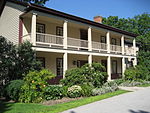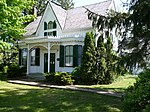Devil's Punch Bowl (Hamilton, Ontario)

Devil's Punch Bowl is a 37-metre ribbon waterfall on the Niagara Escarpment, in the Stoney Creek community of Hamilton, Ontario, Canada. It is found in the Devil's Punchbowl Conservation Area, maintained by the Hamilton Conservation Authority, and features an escarpment access trail with connections to a recently improved section of the Bruce Trail. Stoney Creek's Dofasco 2000 Trail is nearby. The Punch Bowl is also known as Horseshoe Falls for the distinctive shape of the cliff-face, which somewhat resembles its much larger cousin in Niagara Falls. In addition to the 800 km-long Bruce Trail, nearby attractions include the historic Battlefield House Museum and Nash-Jackson House; on Lake Ontario, Fifty Point Conservation Area and Confederation Park; and Mohawk Sports Park and the Hamilton Museum of Steam & Technology in the city proper. There's also a convenience store, restaurant, motel, gas station and retail stores nearby.Lower Punch Bowl Falls is a curtain waterfall located a few metres north of the Punch Bowl, spanning 7 metres in height and width.
Excerpt from the Wikipedia article Devil's Punch Bowl (Hamilton, Ontario) (License: CC BY-SA 3.0, Authors, Images).Devil's Punch Bowl (Hamilton, Ontario)
Ridge Road, Hamilton Stoney Creek
Geographical coordinates (GPS) Address Nearby Places Show on map
Geographical coordinates (GPS)
| Latitude | Longitude |
|---|---|
| N 43.2104 ° | E -79.7558 ° |
Address
Ridge Road 131
L8G 1P3 Hamilton, Stoney Creek
Ontario, Canada
Open on Google Maps









